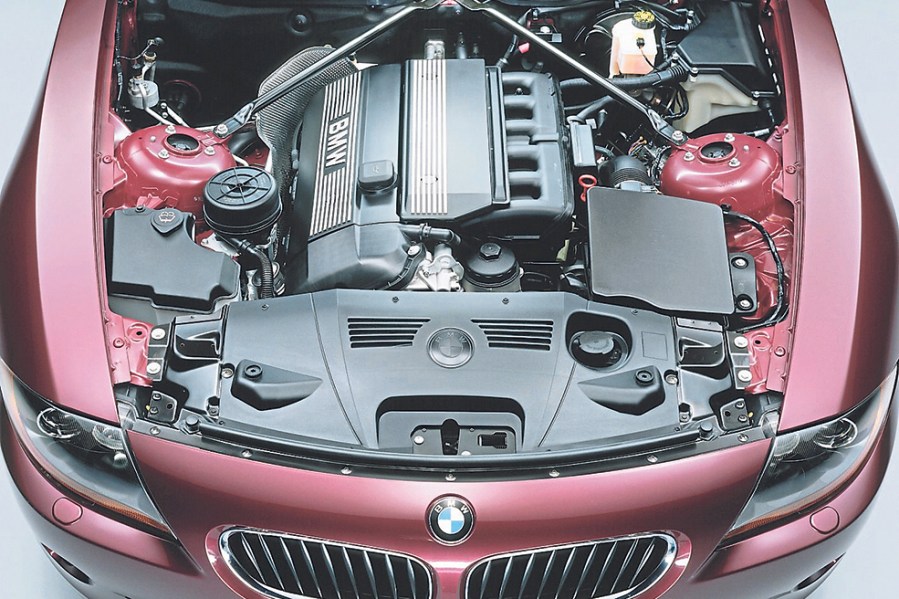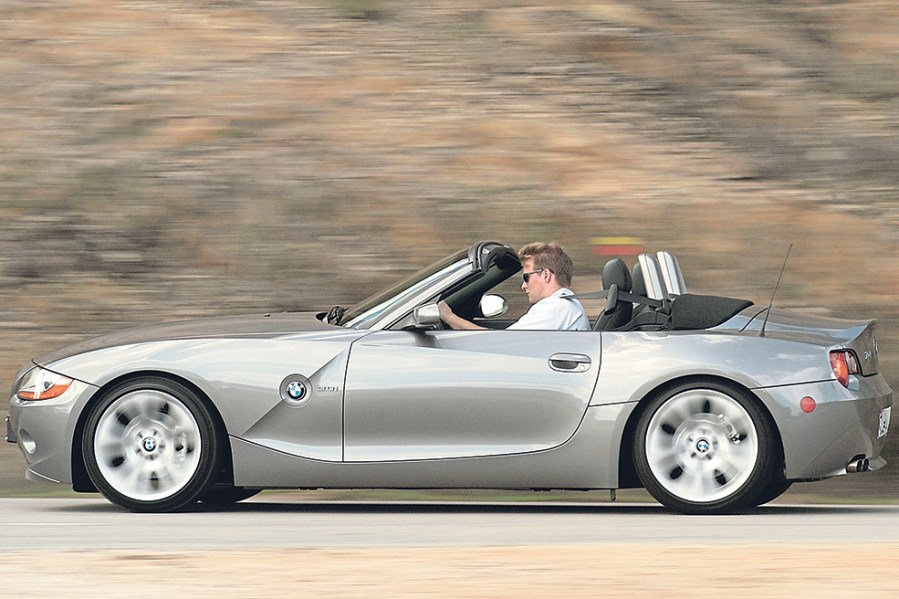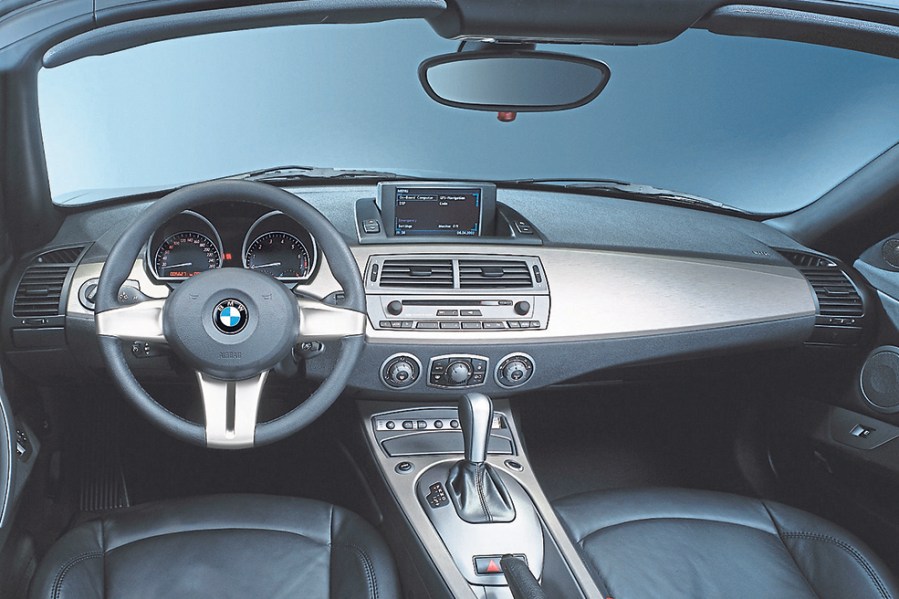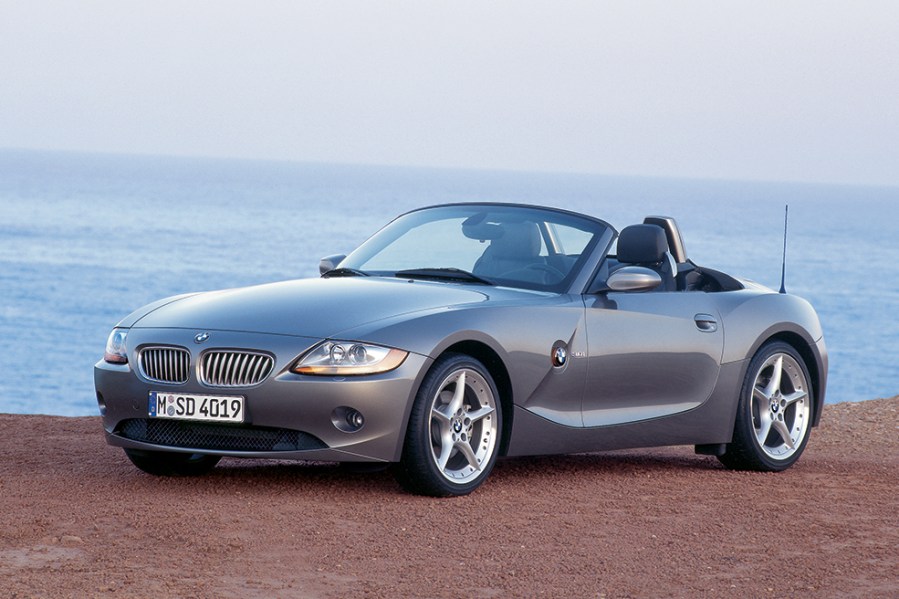It’s easy to see the appeal of the BMW Z4 – a car that combines quality and style with rewarding manners and great engines. Here’s how to buy one
Words: Andrew Everett
Could the BMW Z4 be today’s roadster bargain? The Mazda MX-5 is pleasant enough if you’re happy with synthetic trim and four cylinders, while the Z3 has climbed steeply in price of late. With the best 2.8- and 3.0-litre Z3s now commanding £5000-£10,000, the Z4 looks tempting at roughly half. It may not yet be widely seen as a classic, but now over 20 years old and with a loyal following, it’s arguably a smarter buy than the E89 successor with its folding metal roof and troublesome turbos.
Launched in 2003, the E85 Z4 impressed critics with its 170bhp 2.2-, 193bhp 2.5- and 231bhp 3.0-litre straight-sixes, finally offering Boxster-baiting credentials the Z3 lacked. Chris Bangle’s “flame surfacing” design was modern from every angle, and E46-derived suspension meant handling was close to Porsche levels – still regarded as the sports-car benchmark.
In 2005 a cheaper 150bhp 2.0 four-cylinder with six-speed manual arrived, replacing the 2.2i. A year later, BMW introduced the N52 sixes: 215bhp 2.5si and 258bhp 3.0si. The 2006 line-up comprised 2.0i, 2.5si and 3.0si, with the elegant E86 Coupé debuting alongside. The range lasted until 2008, and importantly escaped BMW’s later direct-injection N43/N53 engines – known for troublesome reliability.

BMW Z4 values
E85 Z4s currently trade broadly between £3000-£10,000 for decent non-M models, though low-mileage 3.0-litre coupes can nudge £13,000. Project cars – needing bodywork and potentially pricey mechanical attention – can be had for as little as £1000-£3500, but proceed with caution. The halo Z4M, meanwhile, carries a premium: good examples start around £14,000, with as much as £22,000 asked for the most pristine coupe, depending on mileage, condition, and history. Best value as a useable but appreciating purchase comes in a manual 3.0si with full service history, optional hard top if a roadster, and finished in an unusual original colour.
Insurance Costs
2005 BMW Z4M Roadster, £16,000 value.
Example quote: £399.50 or £417.50 with Agreed Value.Quotation supplied by Lancaster Insurance. Tel: 01480 400761
Quote based on a 45-year-old marketing manager, access to another car, no claims or convictions, club member, 3000 miles per year, no modifications, living in SP2 0HL. Disclaimer: Subject to underwriting criteria. An additional charge may be payable. Authorised and regulated by the Financial Conduct Authority.
Bodywork and interior
Like other BMWs from the Bangle era, the Z4 marked a clear step forward from its predecessor thanks to its strong resistance to rust. You may spot the occasional blister, and cars from harsher northern or coastal climates can show a rather Titanic-like underside, while rear arches can show some paint blister and rust on higher-mileage examples, but overall the Z4 is impressively well-built and doesn’t typically suffer from rot.
Coupes are the main exception, sometimes displaying cosmetic rust along the inner seams of the tailgate; should your Z4 coupe’s bootlid, you’ll have quite a search on your hands and you can expect to pay £500 or more for a second hand one. Headlights can cloud up, but are easily restored, while the optional bigger alloy wheels wear low-profile tyres and can be prone to kerbing and buckling – check their condition carefully and feel for vibration at speed.
Engine and transmission
The Z4’s staple was the M54 straight-six, derived from the E46 3 Series. This all-alloy 24-valve unit represents the final evolution of 1990’s M50, featuring hydraulic tappets, electronic throttle, DISA inlet valve, coil-on-plug ignition and cats on the manifolds. They’re all generally robust, but the 2.5 is considered the sweet spot. The 2.2 sounds good but suffers from oil use when rings wear, often leading to swaps for 2.5s. The 3.0 can also drink oil at a rate of roughly 500-1000 miles per litre. The 2.5, with 193bhp and healthy torque, is more dependable. Typical M54 issues include oil leaks from filter housing gaskets and cam cover rubbers, with CCV replacement a fiddly but sometimes necessary job. Use quality parts – BMW or Febi – and consider a DISA rebuild if needed.
The 2.0-litre N46 four-cylinder is far less appealing. Unless maintained impeccably, it leaks heavily, wears chains and guides by 100k, and suffers VANOS and Valvetronic issues plus fragile flywheels. Only buy with perfect history, and only if insurance makes a bigger six-pot impractical.
Later N52 sixes are stronger but still leak oil, and their belt tensioners can fail catastrophically. Electric water pumps often expire around 100k (a new Pierburg item costing £300), though VANOS and Valvetronic are more reliable. Although rare, worn cam bearing ledges can also trigger costly repairs. Crankcase breathers, meanwhile, are cheap and simple to replace and repair.
M54 2.2 and 2.5 cars used Getrag 250G five-speeds, tough and cheap to replace, with a five-speed auto optional and turning the sporty Z4 into more of a cruiser. The 3.0 offered a six-speed manual or auto, though the SMG option should be avoided for its poor reliability and slow and jerky shift compared to more modern offerings.
Clutches, propshafts and diffs are durable, though high-milers may show drivetrain clunks. All Z4s use finned diff covers for cooling, but internals mirror that of the E46 and accordingly, limited-slip items can be retrofitted.

Running Gear
The Z4 shares its suspension with the E46, using MacPherson struts up front and the rear Z-axle. At the front, dampers are a wear item but inexpensive thanks to E46 parts compatibility, new shocks costing around £70 per corner. Alloy control arms suffer worn lower ball joints, and while replacement requires complete arms (a pair costing around £80-£100), quality items are worth the extra – BMW’s value line kits are a good bet. Avoid fitting cheap rear ‘lollipop’ bushes; use genuine or poly replacements, as the oil-filled budget versions fail quickly.
At the rear, worn Z-arm outer bushes cause odd ‘rear steer’ effects. With the correct tool they’re straightforward, if time-consuming, to replace. Proper BMW bushes without the slotted casing are best, as the cheaper types can creep out and knock. Rear coil springs commonly lose a bottom coil but are equally simple and cost-effective to swap.
The electric power steering was an unusual departure from the E46’s hydraulic setup. Its PAS motor is integral with the steering column, and when it fails the steering becomes heavy, the dash warning light illuminates, and engine power can be reduced as traction control loses PAS data. Diagnostics won’t talk to the unit, and while BMW charges thousands for a new column, specialists can rebuild the original, or a good used unit is another option at circa-£200.
Beyond that, issues are mostly the usual age-related fare: corroded brake pipes, perished hoses, and tired discs and pads. The handbrake uses small shoes inside the rear discs, and most need proper overhaul or adjustment at the drum, not just by tightening the cable. Genuine BMW shoes are strongly recommended. ABS systems are generally reliable, and sensors, pumps, ECUs, and pressure sensors remain inexpensive new or used.

Interior and Electrics
The Z4’s cabin is solid, with sturdy seats and door cards, while the window regulators generally hold up well, though replacements are expensive – making a good used unit at around £50 the sensible option. Every Z4 Roadster comes with a powered hood, its electro-hydraulic pump housed in a plastic box tucked behind the passenger seat in the boot. This is awkward to reach and vulnerable to water ingress, often leading to corrosion and seizure. A serviceable used pump costs about £100, with reconditioned units around £250, though some owners resort to manual operation using just the electric clamp. The hood is compact and easy to move by hand, and preventative fixes include drilling drainage holes or relocating the pump box inside the boot. Otherwise, electrically the Z4 is sound, essentially an E46 in roadster form.
BMW Z4 (E84): our verdict
You’ll struggle to find a better sports car bargain than a six‑cylinder BMW Z4. It’s an attractive car that drives superbly, sounds fantastic and ages gracefully. Values aren’t expected to rise significantly in the near term, but a well‑kept example should repay its purchase price, and perhaps a little extra.
If you’re tired of the inflated Mk1 MX‑5 market, or need more space and performance than rivals like the Toyota MR‑2 or Mercedes SLK, the BMW Z4 is an ideal choice for open‑top motoring enjoyment.
BMW Z4 timeline
2002
BMW unveils the first-generation Z4 (E85), replacing the Z3. Available initially as a two-seat roadster
2003
UK sales commence in March, with 2.5i and 3.0i six-cylinder models. Distinctive styling by Anders Warming receives positive attention. 2.2-litre model added in autumn
2005
Four-cylinder 2.0 added
2006
Updates see 2.2 dropped an N52 six-cylinder engine replace M54. 3.2 Z4M added, and Z4 Coupé launched (E86), offering a fixed‑roof alternative to the Roadster (available as 3.0 and M only)
2008
E85/86 production ends, making way for the second-generation Z4 (E89) with retractable hardtop
































